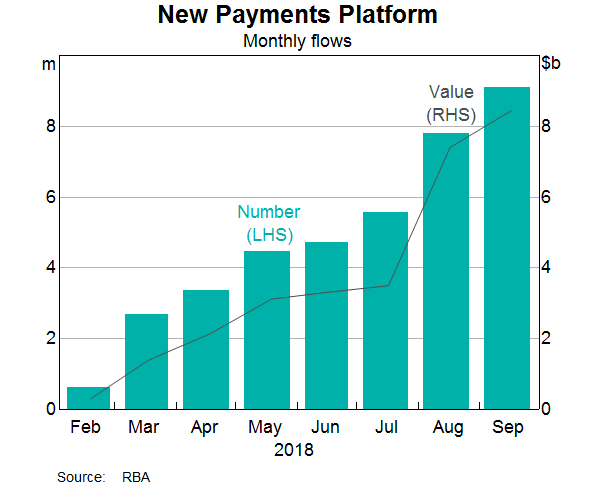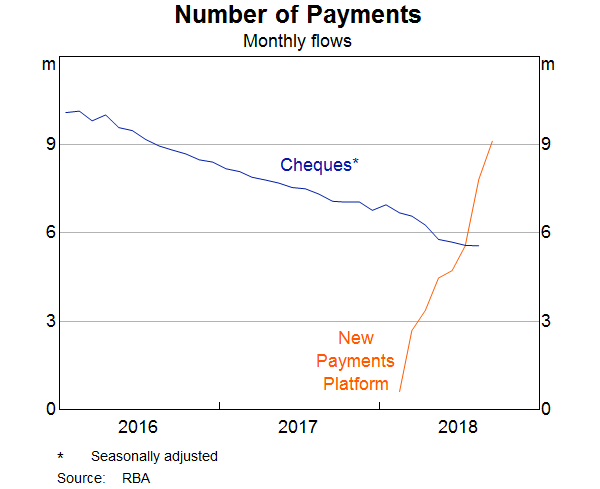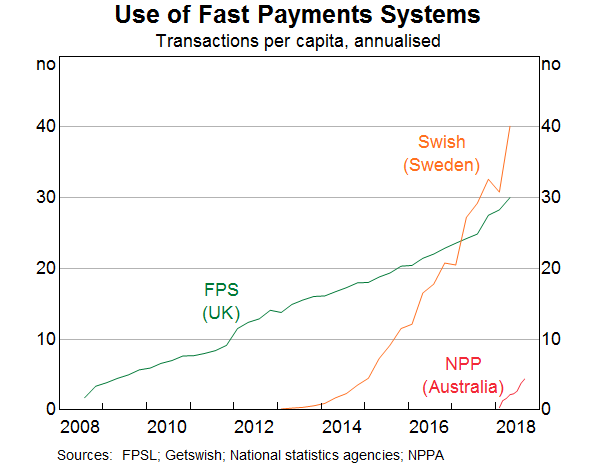Tony Richards, RBA Head of Payments Policy Department spoke at the Chicago Payments Symposium, Federal Reserve Bank of Chicago and described the progress on the new payments platform – NPP. 2 million PayID registrations have been achieved so far, and the volume of payments has already outpaced cheques in the system.
Initial NPP operations
After industry testing through much of 2017, the NPP became operational for industry ‘live proving’ in November 2017. It was launched for public use on 13 February this year. This involved around 50 institutions initially, with this number now having increased to around 65 institutions.
As with any completely new payment system, financial institutions have mostly taken a staged approach in their rollout strategies, gradually introducing services, channels and customer segments. In some cases this was to manage risk and allow them to fine-tune their systems and processes, while in other cases it has reflected different stages of readiness. The major banks have mainly focused initially on providing payment capabilities to consumers ahead of businesses, with the rollout to consumers now at a fairly advanced stage.
At this point, there are more than 50 million Australian bank accounts accessible via the NPP, with that number growing steadily. The number of PayID registrations has just reached 2 million – Australia has a population of 25 million. And monthly volumes and values of NPP transactions have been growing strongly.
One interesting statistic is that the number of payments occurring through the NPP has already surpassed the number of cheques that are being written by Australian households, businesses and government entities
An international comparison also offers another interesting metric. While each country is its own special case, it appears that the adoption of the NPP is proceeding at least as quickly as occurred for some other fast-payment systems
As long as the rollout of NPP to households has not been completed, advertising of Osko by BPAY has been limited, but I would expect that this will be picking up, and that financial institutions will also be doing more promotion of real-time payments to their customers. So I would expect the value and volume of NPP transactions to continue to grow strongly.
Some early lessons learned
While the NPP was launched less than eight months ago, I think one can make a number of observations that may be of interest to this audience regarding its design and build, as well as its operation to date.
The presence of a well-resourced project office (from KPMG as well as from APCA and then NPPA) that was independent of the participants was important in the design, build and test phases. This ensured high quality papers for meetings, brought skills that might not have been readily available from participants, and provided independent perspectives during debates about the design and build
Having three aggregators (or service providers) involved as participants was important in ensuring the broad reach (and public legitimacy) of the NPP. The majority of the institutions that were ready to go on Day 1 were small banks, credit unions and building societies using the services of aggregators.
While the build of the Basic Infrastructure and FSS in the centre were major projects, the internal builds for NPP participants were the most challenging tasks. The systems of large banks are inevitably extremely complex, and upgrading them to allow real-time posting and 24/7 operation has taken longer than expected for some. Banks have also placed significant focus on ensuring that their fraud detection systems can support real-time payments.
Ubiquity (or near-ubiquity) is important. It is hard for a new payment system or for individual participants to go out and market aggressively to customers until a critical mass of institutions and accounts are on board. However, balancing this point and the previous one is a challenge. Decisions to launch to the public can only occur once a critical mass of participants is ready, but a program cannot be expected to move at the pace of the slowest participant.
Real-time settlement is going well. The challenges raised by out-of-hours and weekend operations can be met by appropriate central bank liquidity arrangements. Banks can easily move the balances in their Exchange Settlement accounts between the FSS and the RBA’s main RTGS system during normal business hours. These balances are then all moved into the FSS overnight and on weekends. In addition the Reserve Bank introduced a new liquidity facility for open-dated repos, which are available to holders of Exchange Settlement accounts at no penalty relative to the Bank’s policy rate.
Five or six years ago, some banks may have questioned the case for moving to real-time payments, however no one is questioning that case now. Indeed, the early signs are that banks are looking to move their Direct Entry payments over to the fast rails sooner than was earlier expected. Similarly, the decision to move to the ISO 20022 message format and richer data will be an important one for future innovation.
It was important to have the Addressing Service ready to launch on Day 1. PayIDs get around the problems of end-users having to enter lots of numbers, give certainty about the recipient, help avoid ‘fat finger’ problems and mistaken payments, and can reduce fraud.
The involvement of the central bank – from the policy side, as well as in the delivery of settlement arrangements and as a banking service provider – has been important. I suspect that some industry participants may initially have had some concerns about having the Reserve Bank involved, but that they would recognise now that our involvement helped to get some key aspects of the design, build, and business rules right.
The fact that the Basic Infrastructure will be operated as an industry utility available to all, with commercial payment services to be provided by separate overlay services, was also helpful in getting agreement among participants in the design phase.
With the initial build mostly complete, the industry has ambitious plans for additional NPP functionality. While some of this could potentially be delivered via overlay services, it is likely that there will be additional central functionality provided or arranged by NPPA – for example, possibly a central consent and mandate service that could be used to enable direct debits though the NPP. As NPPA increases its capabilities, it may also look to new means of providing functionality. On Friday it announced an API framework with three sample APIs.




